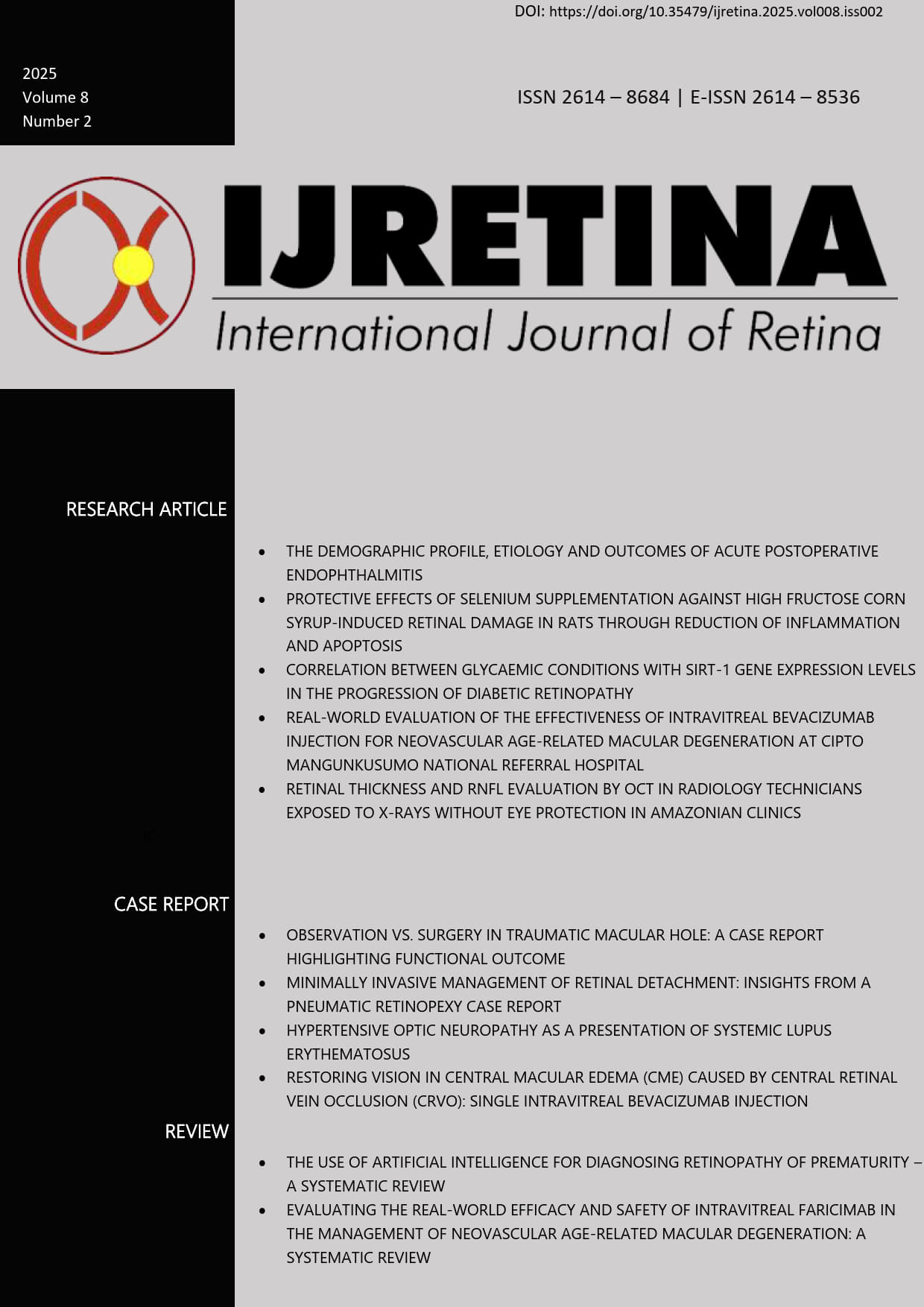OBSERVATION VS. SURGERY IN TRAUMATIC MACULAR HOLE: A CASE REPORT HIGHLIGHTING FUNCTIONAL OUTCOME
Main Article Content
Abstract
Introduction: Traumatic macular hole (TMH) is a rare consequence of blunt ocular trauma, often leading to visual impairment. While spontaneous closure is possible, the decision between observation and surgical intervention remains debated.
Case Report: A 15-year-old male presented with blurry vision in his left eye two weeks after being punched. Examination revealed a macular hole, choroidal rupture, and vitreous hemorrhage. Optical coherence tomography (OCT) confirmed a full-thickness macular hole. Given the potential for spontaneous closure, a three-month observation period was chosen. Follow-ups showed no improvement in visual acuity or anatomical closure, leading to the decision against surgery.
Discussion: While vitrectomy has high anatomical success rates, final visual acuity may not differ significantly between surgically and spontaneously closed holes. Factors such as initial visual acuity, ellipsoid zone integrity, and associated ocular injuries influence functional outcomes. In this case, the presence of choroidal rupture and vitreous hemorrhage supported the decision for conservative management.
Conclusion: TMH management should balance anatomical and functional outcomes. Observation is a reasonable approach in select cases, particularly in younger patients with a chance of spontaneous closure. Individualized treatment decisions are essential, considering potential surgical risks and visual prognosis.
Keywords
Macular Hole, Traumatic Macular Hole, Blunt Ocular Trauma, Functional Outcome
Article Details

This work is licensed under a Creative Commons Attribution-NonCommercial 4.0 International License.
References
2. Kuhn F, Morris R, Mester V, et al. Internal limiting membrane removal for traumatic macular holes. Ophthalmic Surg Lasers. 2001; 32: 308–315.
3. Flynn TH, Fennessy K, Horgan N, et al. Ocular injury in hurling. Br J Sports Med. 2005; 39: 493–496.
4. Gao M, Liu K, Lin Q, et al. Management modalities for traumatic macular hole: a systematic review and single-arm meta-analysis. Curr Eye Res. 2017; 42: 287–296.
5. Johnson RN, McDonald HR, Lewis H, et al. Traumatic macular hole. Ophthalmology. 2001; 108: 853–857.
6. Budoff G, Bhagat N, Zarbin MA. Traumatic macular hole: diagnosis, natural history, and management. J Ophthalmol. 2019; 2019: 5837832.
7. Rubinstein A, Bates R, Benjamin L, et al. Iatrogenic eccentric full thickness macular holes following vitrectomy with ILM peeling for idiopathic macular holes. Eye. 2005; 19: 1333–1335.
8. Pelayes D, De Ribot FM, Kuhn F, et al. Traumatic macular hole: clinical aspects and controversies. Lat Am J Ophthalmol. 2020; 3: 3.
9. Venugopal R, Das AV, Takkar B, et al. Real-world experience of full-thickness traumatic macular hole among young patients. Int J Retina Vitr. 2024; 10: 20.
10. Miller JB, Yonekawa Y, Eliott D, et al. Long-term follow-up and outcomes in traumatic macular holes. Am J Ophthalmol. 2015; 160: 1255-1258.e1.
11. Yamashita T, Uemara A, Uchino E, et al. Spontaneous closure of traumatic macular hole. Am J Ophthalmol. 2002; 133: 230–235.
12. Chen H, Chen W, Zheng K, et al. Prediction of spontaneous closure of traumatic macular hole with spectral domain optical coherence tomography. Sci Rep. 2015; 5: 12343.
13. Tang YF, Chang A, Campbell WG, et al. Surgical management of traumatic macular hole: optical coherence tomograhy features and outcomes. Retina. 2020; 40: 290–298.
14. Miller JB, Yonekawa Y, Eliott D, et al. A Review of Traumatic Macular Hole: Diagnosis and Treatment. Int Ophthalmol Clin. 2013; 53: 59–67.
15. Lei C, Chen L. Traumatic macular hole: clinical management and optical coherence tomography features. J Ophthalmol. 2020; 2020: 1–10.
16. Majumdar S, Tripathy K. Macular Hole. In: StatPearls. Treasure Island (FL): StatPearls Publishing, http://www.ncbi.nlm.nih.gov/books/NBK559200/ (2025, accessed 25 February 2025).
17. Huang J, Liu X, Wu Z, et al. Comparison of full-thickness traumatic macular holes and idiopathic macular holes by optical coherence tomography. Graefes Arch Clin Exp Ophthalmol. 2010; 248: 1071–1075.
18. Yanagiya N, Akiba J, Takahashi M, et al. Clinical characteristics of traumatic macular holes. Jpn J Ophthalmol. 1996; 40: 544–547.
19. Liu W, Grzybowski A. Current management of traumatic macular holes. J Ophthalmol. 2017; 2017: 1–8.
20. Arevalo JF, Sanchez JG, Costa RA, et al. Optical coherence tomography characteristics of full-thickness traumatic macular holes. Eye Lond Engl. 2008; 22: 1436–1441.
21. Thanos A, Todorich B. Traumatic macular holes: to operate, or not to operate, that is the question. Ann Transl Med. 2020; 8: 916–916.
22. Chen H-J, Jin Y, Shen L-J, et al. Traumatic macular hole study: a multicenter comparative study between immediate vitrectomy and six-month observation for spontaneous closure. Ann Transl Med. 2019; 7: 726–726.
23. Wendel RT, Patel AC, Kelly NE, et al. Vitreous surgery for macular holes. Ophthalmology. 1993; 100: 1671–1676.
24. Smiddy WE, Glaser BM, Thompson JT, et al. Transforming growth factor-β2 significantly enhances the ability to flatten the rim of subretinal fluid surrounding macular holes: preliminary anatomic results OF A multicenter prospective randomized study. Retina. 1993; 13: 296–301.
25. Glaser BM, Michels RG, Kuppermann BD, et al. Transforming growth factor-β2 for the treatment of full-thickness macular holes. Ophthalmology. 1992; 99: 1162–1173.
26. Huang J, Liu X, Wu Z, et al. Classification of full-thickness traumatic macular holes by optical coherence tomography. Retina. 2009; 29: 340–348.

